#Celtic rites
Explore tagged Tumblr posts
Text
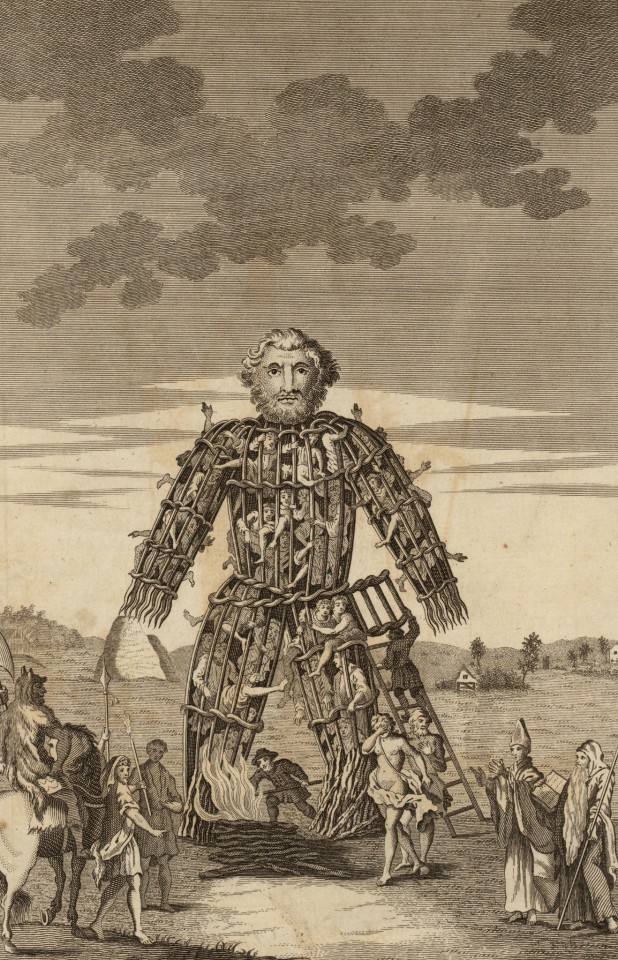
The Wicker Man of the Druids
An 18th-century illustration of a wicker man. Engraving from A Tour in Wales written by Thomas Pennant (1726-1798).
#wicker man#the wicker man#thomas pennant#engraving#18th century#art#arte#history#kunst#vintage#illustration#celtic religion#celtic faith#celtic mythology#celtic#gauls#wales#welsh#julius caesar#de bello gallico#commentarii de bello gallico#celtic rites#druids#homme d'osier#hombre de mimbre#wierzbin#wickerman#wiklinowy pan#homem de palha#homem de vime
587 notes
·
View notes
Text
Goodbye to this year. A Sacred Fire for our beloved ones. Tomorrow will be a new start, a new moon, maybe a new life. Let's drink and light a candle for the ones left behind.
1 note
·
View note
Text

Alternate Gawain ending: He becomes a saint!?

#Celtic Rite Saints just built different#And I love them for that#Sir Gawain#Arthurian#Arthuriana#More proof Diu Crone writer had the biggest brain for making Gawain the Grail Knight#arthurian legend#lou's arthurian ramblings
66 notes
·
View notes
Text

Chapter Two - The Wedding Nite (I told you it would be soon) Rated M (implied content, lots of sultry looks, thoughts, and actions)
Summary is the same as the snippet I shared yesterday (it's only about 1.2k. Can't give it all away 😉)
He hadn't stepped in the Syger's path with the intent of winning her affections. It had been pure instinct, knowing her life was his to protect, no matter the cost. His life was insignificant in comparison. If he should fall in battle, the world would continue its eternal turning, but surely it would cease to exist if anything were to happen to her.
She was the sun. He was the moon.
Thanks bunches @bahbahhh who looked the first part over previously and this spicier part to make sure they mesh somewhat seamlessly. I guess Link’s thoughts run a bit hotter than Zelda's 😂 hence the rating change. Enjoy some Thursday spice 😅. They are primitive newlyweds ya'll.
Oh, and this chapter was inspired by another Loreena McKennitt song The Mummers’ Dance
#legend of zelda#zelink#the legend of zelda#original legends#bronze age#wedding rites#wedding nite#loosely based on celtic lifestyle and tradition
17 notes
·
View notes
Text



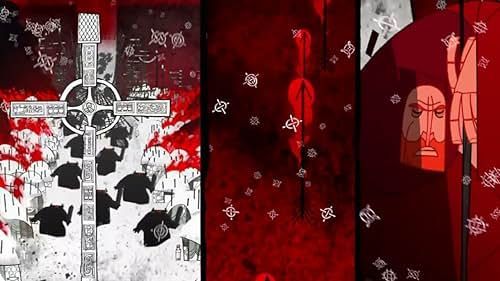
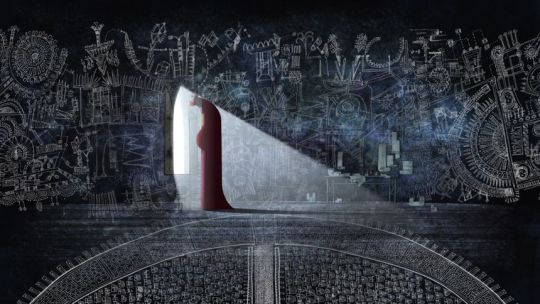
If you haven't seen the film Secret of Kells, you're missing out! It's a wonderful little animated film which gives the (somewhat fictionalized) accounting of the completion of the illuminated manuscript The Book of Kells. The story is told using absolutely beautiful illuminated art style and combines Celtic folklore with Celtic Christianity. It's a story of faith, magic, and one of the greatest books ever produced by the Orthodox West. Also my kids love it. They demand to watch it again and again.
#orthodoxy#orthodox christianity#orthodox church#western orthodoxy#celtic mythology#celtic folklore#celtic christianity#western rite orthodox#celtic monasticism#orthodoxleftist#inclusiveorthodoxy#book of kells#queer christian#faithfullylgbtq#trans christian#thisglassdarkly
27 notes
·
View notes
Text
The Winter Solstice: A Multifaceted Exploration
Happy Winter Solstice! Photo by Pixabay on Pexels.com The Scientific Understanding of the Winter Solstice The Winter Solstice occurs annually around December 21st or 22nd in the Northern Hemisphere, marking the shortest day and the longest night of the year. Scientifically, this event results from the Earth’s axial tilt of approximately 23.5 degrees. As the planet orbits the Sun, the tilt…
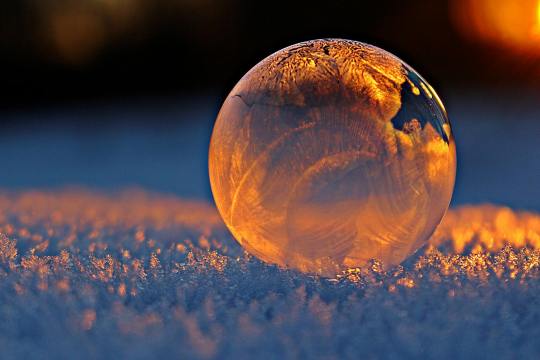
View On WordPress
#Alchemy#Beltane#Celtic culture#Christmas#connection#culture#Duality#Freyr#holidays#hope#Imbolc#interconnectedness#magick#Mithras#Mitra#Nigredo#occultism#Odin#pagan#Raffaello Palandri#Rebirth#renewal#resilience#rite#ritual#Samhain#Sol Invictus#traditions#Viking#Wheel of Life
4 notes
·
View notes
Text




ALBUMS THAT SHAPED BLACK METAL
Celtic Frost:
Morbid Tales
To Megatherion
Into the pandemonium
Hellhammer:
Satanic rites
#celtic frost#hellhammer#morbid tales#to megatherion#into the pandemonium#satanic rites#black metal#proto black metal#tom g warrior
2 notes
·
View notes
Text

The Inspector unwittingly participated in a Celtic rite
when he burnt the Melanophilus in ‘The Kidnapped Groom’.
#Inspector Spacetime#Samhain#the Inspector (character)#unwittingly participated in#Celtic rite#Samhain bonfire#when he burnt#the Melanophilus (species)#The Kidnapped Groom (special)
2 notes
·
View notes
Video
youtube
Whispers of the Ancients - Celtic Spirit Summoning Rite #psytrance
0 notes
Text


















LOTS OF PUNK STAMPS! (part 1)
Here we are with another part of music genre stamps. Just like the goth stamps i made, its a "my favorite genre is in this stamp" + aesthetic stamp combo.
Punk genres listed for this batch, because theres so many punk genres
Anarcho-Punk (i.e. Crass, Rudimentary Peni, The Mob, Lost Cherrees)
Celtic Punk - punk + celtic music (i.e. Dropkick Murphys, Flogging Molly)
Chain Punk - from the meme involving "chain vs egg punk". Has more hardcore punk roots, aggressive
Egg punk - from the meme involving "chain vs egg punk". Quite similar to synth punk due to usage of synths.
Crust punk (i.e. Nausea, Axegrinder, Doom, Deviated Instinct. Aus Rotten)
D-Beat - artwork inspired by those "d beat album covers that has band members censored eyes". Bands like Discharge (where the genre name is from), Anti Cimex, Driller Killer
Emo/Emotional Hardcore (more focused on bands like Rites of Spring, American Football, Jimmy Eat World, and all of those stuff. I'll try to make a different emo stamp for the likes of MCR, Fall Out Boy, and Paramore)
Folk Punk (i.e. Pat the Bunny, Days n Daze, Mischief Brew)
Grindcore - even it's more related to metal. I decided to include here since it was rooted from hardcore punk. Example bands: Napalm Death, Extreme Noise Terror
Digital Hardcore - electronic music + hardcore punk. Some mostly use guitars (i.e. Rabbit Junk) and some will have mostly electronic sounds than guitar (i.e. Machine Girl). Decided to have more cyberpunk aesthetic for this, 'cause it sounds like stuff you play in middle of a fight in a cyberpunk world
Hardcore Punk - apparently "hardcore" can mean different music genres (Beatdown hardcore is one of it but theres also hardcore techno), but lets focus on the punk. Bands like Bad Brains, Black Flag, Dead Kennedys, and Minor Threat.
Horror Punk - spooky punk music. (i.e. Blitzkid, Misfits, Calabrese)
Oi! (i.e. Oi Polloi, Angelic Upstarts, Camera Silens)
Punk Rock - supposedly for the classic punk rock sound but stamp can be used for punk rock in general. Example bands: The Clash, Ramones, Sex Pistols
Ska punk (i.e. Operation Ivy, Less than Jake, Against all Authority)
Skate Punk - something you have heard on Tony Hawk pro skater games. Anyway... bands like NOFX, Suicidal Tendencies (also metal), Pennywise
Street Punk (i.e. GBH, Varukers, UK Subs)
Synth Punk (i.e the Screamers, Suicide, Devo)
feel free to use it to your personal page, carrd, neocities, strawpage, toyhouse, sheezy, deviantart, etc. No need to credit when using the stamps (like putting html embeds and stuff) but linking any of my pages is appreciated when reposted, reblog, or reupload on different places.
#hydrangea shelter music genre stamps#stamps#web resources#web graphics#page decor#deviantart stamps#web stamps#stamp#resources#neocities#webcore#rentry resources#rentry graphics#carrd graphics#carrd decor#carrd resources#punk#anarchopunk#anarcho punk#celtic punk#chain punk#crust punk#d beat#egg punk#emo#emotional hardcore#folk punk#grindcore#digital hardcore#hardcore punk
1K notes
·
View notes
Text
WAYS TO CELEBRATE THE SABBATS

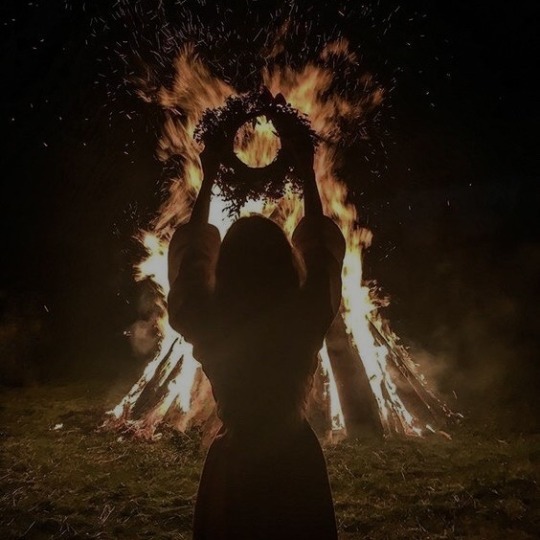
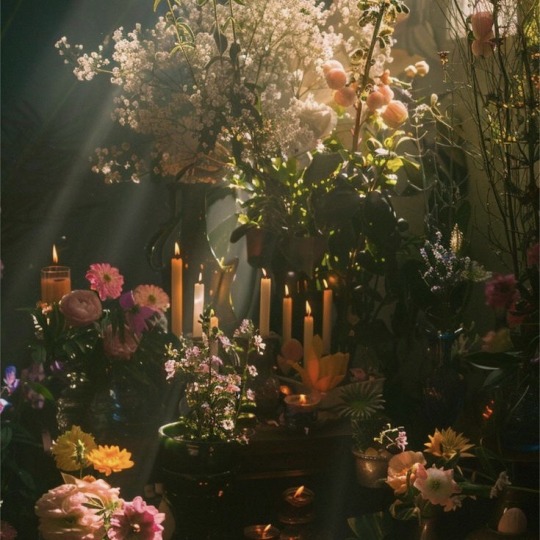
IMBOLC (CANDLEMAS)
Clean your home and space to welcome the coming of spring.
Bake a traditional Imbolc loaf of bread or other seasonal foods.
Use the colours white and yellow in your decorations and outfits.
Light a bonfire or light candles to represent the returning light.
Plant seeds or bulbs to symbolize the rebirth of nature.
Honour deities associated with Imbolc, such as Brigid, Cailleach, Danu, Persephone, Demeter, Pan, The Morrigan, and Freyja.
Perform a ritual to honour the coming of spring and ask for protection and blessings.
Make a Brigid's cross or other handcrafted decorations with herbs and other natural materials.
Perform a blessing of your home and surroundings with holy water or smoke cleansing.
Set up an altar or sacred space to honour the Celtic goddess Brigid, associated with Imbolc.
Make Brigid's bed, a traditional ritual of placing straw under your bed to bring fertility and growth into your life.
Connect with nature and spend time outside to honour the changing season.
OSTARA (SPRING EQUINOX)
Participate in fertility rites and rituals to celebrate the coming of spring and the planting season.
Honour deities associated with Ostara, such as Ēostre, Aphrodite, Persephone, Dementer, Flora, Pan, Hecate, and Freyja.
Create baskets filled with seasonal treats and decorations for loved ones.
Decorate your altar or sacred space with symbols of Ostara, such as eggs, bunnies, daffodils, and pastel colours.
Perform a spring cleaning of your home and life, releasing old habits and welcoming new beginnings.
Light a fire or light candles to honour the return of lighter, longer days.
Bake a traditional honey cake or other seasonal sweets to celebrate the sweetness of spring.
Plant seeds or herbs for new growth and prosperity.
Go for a nature walk or hike to connect with the natural world.
Participate in an egg hunt or egg rolling, traditional Ostara games.
Celebrate the coming of spring with those you care about by sharing a meal.
Perform a protection spell or ritual to honour the increasing light and longer days.
Create a spring bouquet or wreath by using flowers like daffodils, crocuses, and other spring blossoms.
Practice self-care rituals to nourish and rejuvenate your mind and body.
BELTANE (MAY EVE)
Celebrate the fertility of the earth with bonfires and rituals honouring the fire god, Belenos.
Make a maypole and decorate it with colourful ribbons.
Participate in a maypole dance, a traditional celebration of fertility and joy.
Make a wish list and tie it to a tree on Beltane eve.
Collect flowers, especially May blossom or hawthorne flowers, and make a garland or crown to wear.
Honour deities associated with Beltane, such as Belenus, Cernunnos, Freyja, Pan, Flora, Aphrodite, Lilith, Daina, Artemis, and Green Man.
Create a flower crown or wear one made of wildflowers to honour the faery folk and fertility spirits.
Perform a ritual to bless your home and land for prosperity and protection.
Jump over the Beltane bonfires, symbolizing jumping over obstacles and embracing new beginnings.
Have a picnic or gathering with friends and family to celebrate the abundance and growth of the season.
Create a sacred space or altar for Beltane, decorat with flowers, herbs, and other nature-related objects.
Perform a cleansing ritual to rid yourself of negative energy and welcome the energy of new beginnings.
Make a bouquet of wildflowers or herbs, and hang it on your front door to welcome the spirits of Beltane.
Go for a walk in the woods or a natural setting and connect with the beauty and energy of the season.
LITHA (SUMMER SOLSTICE/MIDSUMMER)
Participate in a bonfires or lighting a sacred fire, celebrating the arrival of the longest day of the year.
Collect herbs and flowers, especially ones associated with the sun, such as calendula, yarrow, and St. John's wort, and make a solstice garland.
Perform a ritual to honour the sun and ask for protection and blessings.
Dance around the bonfire or engage in other traditions associated with the Summer Solstice, such as singing and drumming.
Have a solstice feast, filled with summer bounty, seasonal foods, and family.
Celebrate in the natural world, go for a walk, or have a picnic during the longest day.
Honour deities associated with Litha, such as Gaia, Freyja, Sol, Lugh, Sulis, Apollo, Belenus, Lucifer, Danu, Hestia, Asmodeus, Hades, and Ra.
Start summer resolutions.
Get your hands dirty and embrace the earth. Consider planting a vegetable garden for fall harvest or add to your flower garden to mark the occasion.
LAMMAS (LUGHNASADH)
Baking bread.
Crafting corn dolls.
Pick wild flowers.
Honour the earth and the cycles of nature.
Perform Sun magick.
Give thanks to the spirits and/or deities for the beginning of the harvest season.
Collect and honour the first fruits of the harvest, such as grains, corn, and apples.
Perform a ritual to honour Lugh and thank the gods and goddesses for the harvest.
Hold a harvest festival or feast, sharing the bounty of the land with family and friends.
Make a Lughnasadh altar or shrine with symbols of the harvest, such as corn, grains, and apples.
Participate in a traditional Lughnasadh celebration, such as a harvest dance or ritual.
Honour deities associated with Lammas, such as Lugh, Demeter, Ceres, Tailtiu, Danu, Persephone, Freyja, The Morrigan, and Green Man.
Collect herbs and plants for healing and protection, as Lughnasadh is traditionally a time for preparing for the winter months.
MABON (AUTUMN EQUINOX/FALL HARVEST)
Celebrate the balance between light and dark, and the onset of the harvest season.
Participate in a harvest celebration, collecting and honouring the fruits of the land.
Gathering dried herbs, plants, seeds and seed pods.
Make a corn dolly or a straw figure as a reminder of the abundance of the harvest.
Perform a ritual to honour the balance of the seasons and thank the gods and goddesses for their blessings.
Spend time writing in your journal. You could reminisce about your summer experiences, reflect on the shifts you feel with the changing season, contemplate what you're ready to release, or express gratitude for the blessings in your life.
Adorning burial sites with leaves, acorns, and pine cones to honor those who have passed over.
Honour deities associated with Mabon, such as Demeter, Persephone, Ceres, Freyja, Pomona, Green Man, Loki, Modron, Freyr, Osiris, The Morrigan, Dionysus, Epona, Donn, the Muses, Hermes, Thor, Mabon, and Thoth.
Participate in a nature walk or ceremony, taking time to connect with the natural world and the turning of the seasons.
Enjoy your favourite fall beverages.
Make a gratitude list or write a gratitude letter, expressing your appreciation for the abundance and beauty of the harvest season.
Connect with nature.
Bring the beauty of fall indoors by decorating your home with seasonal touches.
Make wine.
Performing a gratitude or release ritual.
SAMHAIN (ALL HALLOWS/FINAL HARVEST)
Carving pumpkins with friends.
Relax and watch some horror movies.
Treat yourself to sweets.
Participate in a haunted house, hayride, or corn maze event.
Declutter/organize your home.
Focus on letting go to make space for the new year.
Honour deities associated with Samhain, such as the Morrigan, Hecate, Cerridwen, Persephone, Hades, Lucifer, Pomona, Lilith, Cailleach, Santa Muerte, Odin, Loki, and Hel.
Collecting leaves.
Bake treats that contain pumpkin.
Creating a spooky, atmospheric decor for your home or workspace, such as cobwebs, faux spiders, and other creepy décor items.
Gathering friends and loved ones for a Samhain feast, feasting on symbolic foods like apples, pumpkin, or corn.
Visit a local pumpkin patch.
Making personalized altar items and decorative pieces for your sacred space, such as witch jars, mandalas, sigils, symbols of the harvest, items associated with death, etc.
Participating in a divination practice like tarot reading, scrying, or rune casting to gain insight and connect with the energy of the night.
Go to a harvest festival or carnival.
Hold a Samhain seance or mediumship session to contact the spirits of loved ones who have passed on.
Participate in a potluck dinner with witches and pagans, dressing in traditional Samhain garb.
RESPECTFULLY visit a graveyard.
YULE (WINTER SOLSTICE/MIDWINTER)
Burn a Yule log.
Make an evergreen Yule wreath.
Decorate a Yule tree.
Make a Yule wish list or a Yule resolution, as Yule is a time of reflection and intention setting.
Practice Yule carol singing, participating in a community sing-along or carolling event.
Celebrate in candle light.
Give back to nature.
Exchange nature-based gifts.
Host a feast for those you love with foods associated with Yule, such as: roast goose, Yule ham, nuts, berries, spices, squash, and potatoes.
Cook/bake or eat Yule ham, gingerbread, mulled wine, roast goose, spiced cakes, shortbread, snowball, caraway, ginger snaps, honey cakes or pastries, and biscuits.
Eat or give sweets flavoured with nutmeg, cinnamon, ginger, or peppermint.
Participate in the longest night of the year and prepare for the return of the light.
Honour deities associated with Yule, such as Odin, Baldur, Hel, Loki, Sol, Freyr, Njörðr with lights, candles, and bonfires.
Participate in a Yule spell or ritual, asking for blessings and protection for the coming year.
Decorate your home with evergreen boughs and wreaths, representing the evergreen nature of the sun and eternal life.
Host a Yule log ceremony.
Participate in an outdoor activity, like sledding or ice skating, to honour the winter season.
#fyp#fypシ#fypシ゚viral#fypage#fyppage#tumblr fyp#witchcraft#witches#witch#witchcore#witchblr#witch community#sabbats#imbolc#ostara#spring equinox#beltane#midsummer#litha#lughnasadh#lammas#autumn equinox#mabon#fall harvest#samhain#all hallows eve#yule#winter solstice#information#wheel of the year
473 notes
·
View notes
Text
Collecting And Utilizing Magick Charms

My personal charm collection.
Magick charms are small, enchanted objects used for protection, luck, attraction, and spiritual power. Witches, shamans, and mystics have used charms for centuries to enhance spells, manifest intentions, and guard against negative forces. This comprehensive guide will help you collect, store, and use charms effectively in your witchcraft.
What is a Magick Charm?
A magick charm is any object infused with energy or intention to create a desired effect. Unlike talismans (which attract energy) or amulets (which repel energy), charms can do both, depending on their purpose.
Uses of Magick Charms in Witchcraft:
• Protection – Shields against negative energy, hexes, and harm.
• Luck & Prosperity – Draws fortune, money, and success.
• Love & Attraction – Enhances self-love, relationships, and passion.
• Healing & Wellness – Promotes emotional, physical, and spiritual health.
• Psychic Abilities & Divination – Strengthens intuition, dreamwork, and spirit communication.
• Manifestation & Goal Achievement – Focuses energy on specific desires.
Collecting Magick Charms
Magick charms can be found, crafted, or gifted. The key is choosing objects that resonate with your energy and intention.
Where to Find Charms:
• Nature – Stones, feathers, shells, acorns, bones, dried herbs.
• Thrift Shops & Antique Stores – Old jewelry, keys, trinkets, coins.
• Personal Objects – Lockets, rings, buttons, meaningful tokens.
• Handmade Charms – Sigil-carved wood, cloth pouches filled with herbs, inscribed coins.
• Cultural or Spiritual Items – Religious symbols, runes, lucky talismans.
A List of Magick Charms & Their Meanings
Protection Symbols & Charms:
• Pentacle/Pentagram – A five-pointed star within a circle, symbolizing protection, balance, and the elements.
• Hamsa Hand – A hand-shaped amulet with an eye in the center, used to ward off the evil eye and negative energy.
• Ankh – An Egyptian symbol of life, protection, and divine energy.
• Eye of Horus (Wadjet) – Offers protection, health, and wisdom.
• Algiz (ᛉ) – A rune of protection and higher guidance.
• Triquetra – A three-interwoven loop symbol representing the triple goddess (maiden, mother, crone) and protection.
• Bindrunes – Custom symbols made from Norse runes for specific protective purposes.
• Hexagram (Seal of Solomon) – Used for divine wisdom and spiritual protection.
• Blackthorn (Saining Rod) – A charm in Celtic magic for warding off evil spirits.
Love & Attraction Charms:
• Heart Symbol – Represents love, passion, and emotional connection.
• Venus Symbol (♀) – Associated with love, beauty, and feminine energy.
• Claddagh Ring – An Irish symbol of love, loyalty, and friendship.
• Red String – A Kabbalistic charm for protection and attracting love.
• Rose Quartz – A stone of love, harmony, and emotional healing.
• Apple (Sacred Fruit) – Used in love spells and fertility rites.
Wealth & Prosperity Charms:
• Coin – Standard charm of wealth, success, and prosperity.
• Maneki-Neko (Lucky Cat) – A Japanese charm for attracting fortune and prosperity.
• Four-Leaf Clover – Brings luck, success, and good fortune.
• Fehu (ᚠ) – Manifests wealth, prosperity, and abundance.
• Cornucopia (Horn of Plenty) – A symbol of abundance and wealth.
• Chinese Coins (Tied with Red String) – A feng shui charm for prosperity.
• Citrine (Merchant’s Stone) – Attracts wealth and financial success.
• Elephant with Trunk Up – A charm for good luck and financial stability.
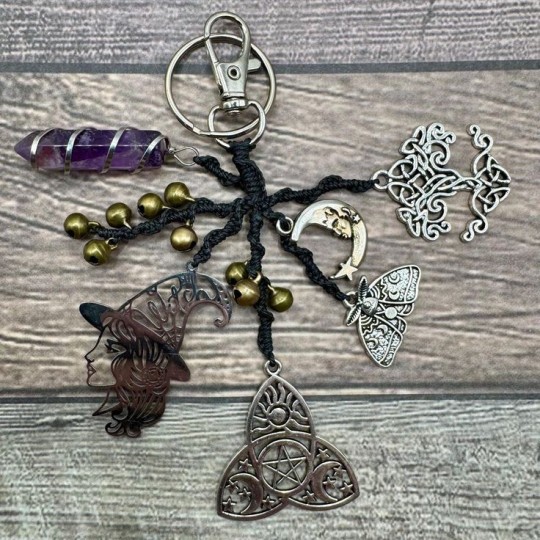
Power & Strength Symbols:
• Thor’s Hammer (Mjölnir) – A Norse symbol for protection and personal power.
• Dragon Symbol – Represents strength, wisdom, and magickal power.
• The Lion (Solar Power) – Represents courage, dominance, and royalty.
• Oak Leaf & Acorn – Strength, endurance, and longevity.
• Sowilo Rune (ᛋ) – Represents the sun’s power, success, and victory.
• Phoenix – A symbol of resilience, transformation, and rebirth.
Wisdom & Knowledge Symbols:
• Key – Unlocks new opportunities, wisdom, and secrets.
• Ouroboros (Serpent Eating Its Tail) – Represents infinite wisdom and cycles of renewal.
• The Owl – A symbol of wisdom, intuition, and the unknown.
• Merkaba (Star Tetrahedron) – Represents spiritual ascension and higher consciousness.
• Celtic Awen – Three rays representing divine inspiration, wisdom, and creativity.
• Feather – A symbol of knowledge, communication with spirits, and travel.
• Shell – Connection to water energy, emotions, intuition.
• The Labyrinth – A journey of self-discovery and enlightenment.
• Spider Web Charm – Symbolic of creativity, patience, weaving fate.
• The Book (Grimoire Symbol) – Represents arcane knowledge and magickal wisdom.
Healing & Health Symbols:
• Caduceus (Staff of Hermes) – Often confused with the Rod of Asclepius, it symbolizes healing and balance.
• Rod of Asclepius – A staff with a serpent, representing medicine and healing.
• Chalice/Grail – A symbol of spiritual nourishment and healing.
• Dove Symbol – Represents peace, purity, and emotional healing.
• Green Aventurine – A crystal associated with heart healing and vitality.
• Healing Hand (Reiki Symbol) – Used in energy healing practices.
Magick & Spiritual Symbols:
• Triple Moon (Waxing, Full, Waning) – Represents the triple goddess and the phases of magick.
• Yin-Yang – Balancing opposing energies, duality, and harmony.
• Infinity Symbol (∞) – Represents limitless potential and eternal cycles.
• Spiral (Sacred Geometry) – Represents cosmic forces, spiritual growth, and energy flow.
• Alchemical Symbols – Such as Sulfur (fire), Mercury (transformation), and Salt (earthly existence).
• The Sigil – A personal or created magical symbol for manifesting desires.
• The Triskelion (Triple Spiral) – A Celtic symbol of motion, progress, and spiritual evolution.
Death & Afterlife Symbols:
• The Scythe – Symbol of death, transformation, and the cycle of life.
• Anubis (Jackal-Headed Deity) – Egyptian guide of the dead and protector of souls.
• Raven & Crow – Messengers of the spirit world, associated with death and prophecy.
• The Skull – Represents mortality, spiritual protection, and wisdom.
• The Black Rose – A symbol of endings, transformation, and mourning.
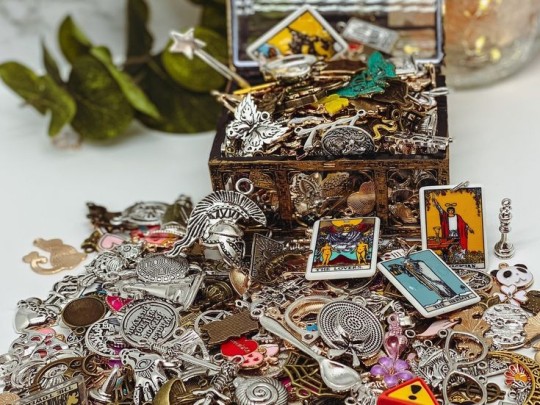
Storing & Carrying Magick Charms
Proper storage keeps charms energetically charged and ready for use. Here are some ideas for how to store your charms:
• Charm Bracelet – Wear daily for constant energy.
• Key Ring – Carry for protection, luck, or travel safety.
• Necklace or Amulet Pouch – Close to the heart for emotional or psychic work.
• Pocket Charm Bag – Small pouches with multiple charms inside.
• Altar Bowl or Plate – Keeps charms cleansed and charged.
• Wooden Box – A sacred space for unused or rotating charms.
• Glass Jars – Store charms by category (protection, love, luck).
• Hanging Charms – Over doorways, windows, or in cars for protection.
Activating & Charging Your Charms
Once stored, activate your charms to align them with your energy and purpose. Here are some methods for charging charms:
• Full Moon Light – Best for charms related to psychic abilities, intuition, and love.
• Sunlight – Increases vitality, confidence, and empowerment.
• Fire Energy – Hold over a candle flame to strengthen power (use fire-safe materials).
• Earth Energy – Bury in soil or place on a crystal for grounding.
• Anointing Oils – Rub with essential oils that match the intention (e.g., rose oil for love, peppermint for clarity).
• Breath & Spoken Word – Whisper affirmations or spells into the charm.
Example Activation Spell:
"By earth, air, fire, and sea,
A charm of power this shall be.
Blessed with magic, strong and bright,
Guided by love, luck, and light."
Using Magick Charms in Witchcraft
Protection Magick:
• Wear as Jewelry – Carry protective charms like pentacles, hamsas, or evil eye symbols as rings, necklaces, or bracelets.
• Hang Above Doorways – Place charms like iron horseshoes, pentagrams, witch bells, or bindrunes on doors to keep negative energy away.
• Pocket or Pouch Carrying – Keep a small charm (such as a rune, hexagram, or protective sigil) in your pocket or mojo bag.
• Car Charm for Safe Travel – Hang protective symbols like an Eye of Horus, hag stone, or hamsa in your car.
• Candle Spell with Protective Symbols – Carve protective sigils or runes onto candles and burn them for shielding energy.
Love & Attraction Magick:
• Charm Bags for Love – Create a sachet filled with rose petals, cinnamon, and love-drawing charms to carry with you.
• Embedding in Jewelry – Enchant a piece of jewelry with attraction energy and wear it to enhance romantic appeal.
• Love Candles – Use pink or red candles and tie love charms to them for love spells.
• Bath Ritual with Love Charms – Place rose quartz or heart charms in bathwater to charge yourself with loving energy.
• Knot Magick with Charms – Tie a ribbon around a love-attracting charm while focusing on your desire.
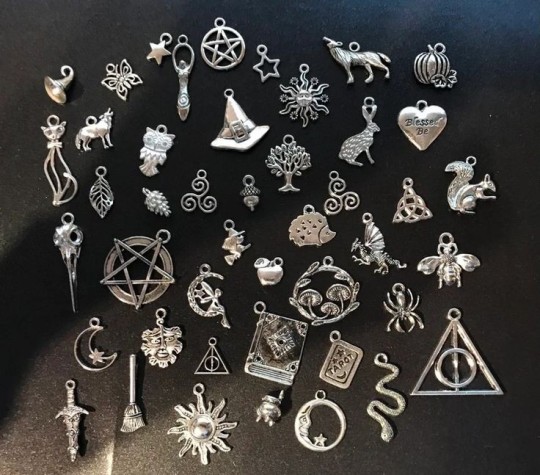
Prosperity & Success Magick:
• Prosperity Jar – Fill a jar with green aventurine, bay leaves, wealth charms and coins to attract wealth.
• Keep Money-Drawing Charms in Wallet – Carry a citrine crystal, Chinese coin, or prosperity sigil inside your wallet.
• Tie Wealth Symbols to Candles – Use green or gold candles and adorn them with symbols for financial success.
• Charm Your Work Desk – Place a charged prosperity charm on your workspace to attract career success.
• Bury a Charm for Long-Term Growth – Plant a coin or lucky charm in the soil with a new plant to manifest sustained wealth.
Healing & Well-being Magick:
• Crystal Healing Charms – Wear or carry stones like amethyst, jade, or lapis lazuli for mental and physical healing.
• Drink Infused Herbal Water – Charge a charm with healing energy and place it beside a cup of herbal tea.
• Create a Healing Amulet – Anoint a small token with essential oils like lavender or rosemary and carry it for health.
• Under-Pillow Charms for Rest – Place a dream charm or amethyst under your pillow to promote restful sleep.
Divination & Psychic Enhancement:
• Pendulum Work – Use a small charm as a pendulum for dowsing and spiritual guidance.
• Charms with Tarot Cards – Keep psychic-enhancing charms with your tarot deck for clearer readings.
• Crystal Ball or Scrying Mirror with Charms – Keep a pentagram, labradorite, or a third-eye charm near scrying tools.
• Create an Intuition Talisman – Carry a charm or rune (such as Algiz or Ansuz) to strengthen intuition.
• Anointing the Third Eye – Use a charm to draw anointing oil onto the third eye for spiritual awareness.
Spirit Communication & Ancestral Work:
• Ancestral Altar Offerings – Place a charm representing your ancestors on your altar to honor and connect with them.
• Use Spirit Keys – Enchant an old key as a tool to unlock communication with spirits.
• Bone or Shell Divination – Keep a charm or marked bones for spirit-based divination.
• Spirit Sigils - Use name sigils or symbols of spirits to connect with them.
• Carve Names on Candles – Inscribe an ancestor’s name on a candle along with a symbolic charm for guidance.
• Use a Spirit Bottle – Fill a small bottle with herbs, salt, and charms to aid in contacting spirits.
Shadow Work & Personal Growth:
• Shadow Work Charm Pouch – Keep black tourmaline or obsidian, a moon, a skull, etc. charm in it for deep introspection.
• Mirror Work – Put a shadow work charm on a mirror and use it for self-reflection rituals.
• Create a Personal Power Amulet – Enchant an item with affirmations for self-empowerment.
Warding & Banishing Negativity:
• Black Salt & Charm Mix – Combine black salt with a protective charm and sprinkle it around your home.
• Smoke Cleansing with Charms – Pass a protective charm through incense smoke to empower it.
• Candle Banishing Ritual – Carve a banishing sigil onto a black candle and burn it while focusing on removing negativity.
• Mirror Magick for Reflection & Deflection – Charge a small mirror charm to send negativity back to its source.
Elemental Magick Uses:
• Earth Charms – Bury a stone charm in soil to manifest long-term goals.
• Air Charms – Hang charms in trees or use feathers to enhance communication and wisdom.
• Fire Charms – Burn symbols in fire to release intentions or perform fire scrying.
• Water Charms – Place charms in a bowl of water under the moonlight for cleansing and intuition.
Dream Magick & Astral Travel:
• Dream Charm Under Pillow – Use an amethyst, moonstone, or dreamcatcher to encourage prophetic dreams.
• Charm on Bed Frame – Put a charm under your bed or mattress to enhance dream recall and astral travel.
• Silver Cord Charm – Carry or wear a silver cord for protection during astral projection.
• Anointing with Mugwort Oil – Use mugwort-infused oil on a charm to enhance dream visions.
Retiring or Disposing of Old Charms
If a charm loses its energy, becomes damaged, or is no longer needed:
• Bury It – Returns energy to the earth.
• Burn It – Safely burn wooden or biodegradable charms.
• Release It into Water – If eco-friendly (e.g., shells, stones).
• Gift It – Pass it to someone who may need its magic.

Magick charms are versatile, powerful tools that enhance spells, offer protection, and bring luck. Whether worn, carried, or placed in a sacred space, they infuse your life with magick while keeping your intentions aligned.
#charms#Charm#symbols#pendant#keycharm#keychain#witch#magick#witchblr#witch community#eclectic witch#eclectic#pagan#enchanted#enchantment#protection#wealth#Luck#spiritual#psychic#power#spirit#spirit work#spellwork#spellcasting#spell#talisman#amulet#symbology#witchcraft
288 notes
·
View notes
Text
My two cents on Dek
I know Dek is a hot topic in the yautja fandom right now. I'm seeing a lot of opinions on him and discussion about his appearance.
I dont care what people think, I'm really digging his look. He looks like a young yautja, a teen. He looks much younger than Chopper, Celtic, and Scar (who I consider more like young adults/older teens). The way that Dek's face is shaped could just be because of his young age and having not matured fully yet. Here's an example for what I mean

Dek could just belong to a species of yautja that has a different developmental stage (because I highly doubt he's part human like a lot of people have been saying about him, given how yautja canonically view humans). Plus, "first hunt, last chance" seems like Dek is going on his very first hunt, NOT CHIVA! (Chiva being what Scar, Celtic, and Chopper were doing in AVP; a ritual hunt as a rite of passage into adulthood) He could still be in the unblood rank, having not hunted anything before.

On top of that, it's confirmed he's a runt; much smaller than the others and wanting to probably prove himself to his clan and to his father. Him being a runt could also be the reason why he looks different.

Some commentary about his appearance
His bottom left tusk looks like it's chipped or has been broken in the past. Due to him being a runt, he has probably been bullied and has suffered from abuse from his peers.
His eyes are so uncanny, and I love it. It gives an unsettling vibe to his appearance
Bro's skin looks soft. This could also play into him being a teen/young. His lack of scars too
His armor looks like what you'd wear as someone who doesn't have much status. Like hand-me-down armor
Conclusion
Dek is a teenager going on his very first hunt for approval and acceptance. He's not half human; he's just young and a runt.
#yautja#predator#alien#the predator#yautja fandom#ramble#thoughts#lore#lore discussion#predator badlands
172 notes
·
View notes
Note
Do you have any headcanons about Wizarding cultural norms and stereotypes?
I love how your brain works ❤️❤️
Thank you ❤️❤️❤️ My brain is mostly fuelled by tea and spite, but it does try. So I love thinking about cultural quirks and here are some of my hcs:
1. Table manners look very different in old wizarding families.
Especially the ones who look down on Muggle etiquette. In some of the oldest families, you eat off a trencher and don’t necessarily use a fork. And there’s a cloth slung over your left shoulder, like in Elizabethan or Tudor times (I still have a bit of Wolf Hall brain rot), that you use to wipe your hands.
2. Birth charts are taken extremely seriously.
Almost every magical child has a birth chart drawn up the day they’re born. St. Mungo’s has an entire department that does this, because it’s considered that important. People absolutely reference their charts in daily life.
3. Wand funeral rites are non-negotiable.
Wands are either buried with the person or ritualistically burnt when someone passes. It’s seen as really bad luck to keep or use a dead person’s wand. A wand goes with its person. Keeping it is taboo and viewed with deep suspicion.
4. The concept of pure-blood varies by culture.
The British definition is very specific, but it’s not universal. Other magical cultures define purity differently. In some places, it’s about the continuity of magical teaching. In others, it doesn’t exist at all as a social category.
5. Family sashes are worn at weddings and then exchanged.
Each member of the wedding party wears their family colours. After the vows, the sashes are exchanged as a gesture of unity and joining. It matters deeply in old magical families and is considered one of the most symbolic parts of the ceremony.
6. Weddings are not white.
In most old magical families, white is considered a colour for mourning. Wedding garments are typically gold, deep red, forest green, or midnight blue. Gold is especially traditional in Mediterranean magical families.
7. Pregnancy is considered a prophetically potent time.
Pregnant witches are often believed to be more magically attuned. It’s common to visit a dream seer during the second trimester — someone trained to interpret the dreams of the expectant mother.
8. First movement is marked with a fire spell.
When the unborn child first kicks or moves, it’s tradition to light a fire with a spell cast by the pregnant witch herself. Then that fire is kept burning until the child is born.
9. You never point your wand at the sky unless you’re making an oath.
It’s an old tradition, possibly Celtic in origin, that raising your wand skyward invokes the elements as witness. Children are warned against it as strongly as they’re warned against Unforgivables. To the sky means a vow, and it is expected to be honoured.
10. Certain flowers are magically significant and avoided indoors.
Lilies are considered death flowers. They are used in soul-anchoring rites during funerals. Forget-me-nots are essential in memory magic and shouldn’t be handled while drinking or before exams. Poppies, used to dull magical pain, are never left near a wand overnight. It’s said they dull a wand’s magical firepower.
11. You don’t write a person’s name in red ink.
Across most wizarding cultures, this is considered deeply disrespectful. Red ink is used in blood pacts, contract severances, and formal magical excommunication. Writing someone’s name in red is a symbolic disowning. Teachers correct essays in green or purple.
12. Family portraits are part of the household warding.
Hanging a portrait of a deceased relative strengthens the home’s protective magic. In older families, these portraits are passed down. Some serve as sentries. Some offer advice or judgemental comments about you.
116 notes
·
View notes
Text
Update! I found this in my queue today scheduled to post later this month 🤣 but I wrapped the second part up a month ago. You can read both parts (they’re short!) on AO3 here
Rating change from T to M for Link’s spicy thoughts 🤣😬😅
WIP Wednesday!

Remember the second part of The Hero and The Priestess I promised MONTHS ago? Well, here's a snippet of what's in store...

#legend of zelda#zelink#the legend of zelda#bronze age#original link and zelda#wedding ceremony#wedding rites#original legends#celtic#Celtic inspired#wedding night
6 notes
·
View notes
Text
The Evil Little Hairy Cave People of Europe in Pulp Fiction

From the 1900s to the 1940s, there was a trendy theme in occult and horror stories that the explanation for widespread European legends of fairies, brownies, pixies, leprechauns and other malicious little people, was that they were a hereditary racial memory of the extremely small non-human, hairy stone age original inhabitants of Europe, who still survive well into modern times in caves and barrows below the earth. Envious of being displaced on the surface, these weird creatures, adapted to the darkness of living underground and unable to withstand the sun, still mean mischief and occasionally go out at night to capture someone.... usually an attractive woman....to take to their dark caves for human sacrifice.
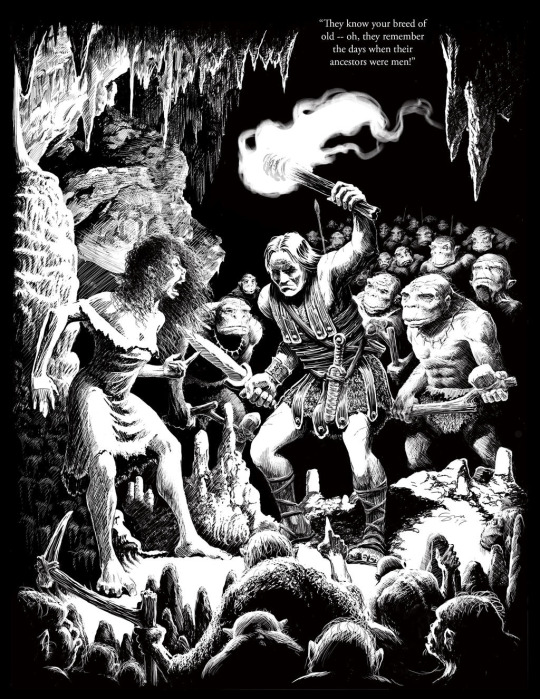
Displaced by the arrival of Indo-European language speakers at the dawn of the Bronze Age, these original, not quite human stone age people of Europe were driven deep underground into caves and barrows below the earth, where they went mad, adapted to the darkness and acquired a fear of daylight, became extremely inbred, in some cases acquired widespread albinism. It is these strange little people who gave the descendants of Europeans a haunting racial dread of places below the earth like mines and caves, and it also is these strange, hairy troglodytes who originally built the uncanny and mysterious menhir, fairy rings, and stone age structures of England, Scotland, and Ireland that predate the coming of the Celts and Romans.
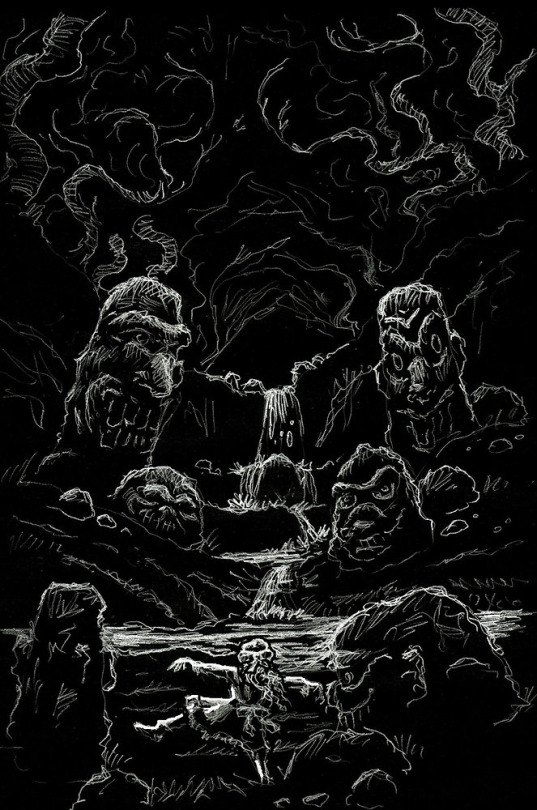
In some cases, these evil troglodytes are usually identified with the mysterious Picts, the pre-Celtic stone age inhabitants of the British Isles. In some cases, they are identified with the Basque people of Spain, best known as the inventors of Jai Alai, and the oldest people in Europe who speak a unique language unrelated to any in the world.
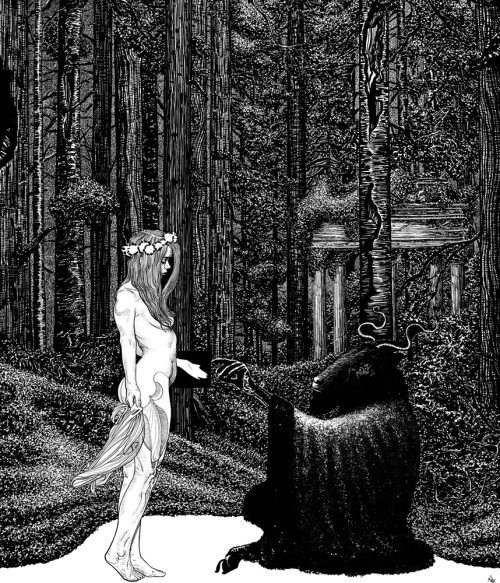
The original codifier of this trend was Arthur Machen, a horror writer who is less remembered than his contemporary, Henry James, but who may be the best horror writer in the generations between Poe on the one end and Lovecraft/CL Moore/Clark Ashton Smith on the other. His story, "the White People" from 1904 (a reference to their strange cave albinism) was a twisted Alice in Wonderland with a girl who is irresistibly attracted to dark pre-Roman stone age ruins and who is eventually pulled underground.
In addition to being a great horror writer, Arthur Machen was a member of the Hermetic Society of the Golden Dawn, an occult organization, and was often seen at the Isis-Urania Temple in London. Many of his works have secretive occult knowledge.
H.P. Lovecraft in particular always pointed out Arthur Machen as his single biggest inspiration, though he combined Machen's dread and occultism with Abraham Merritt's sense of fear of the cosmic unknown, seen in "Dwellers in the Mirage" and "People of the Pit."
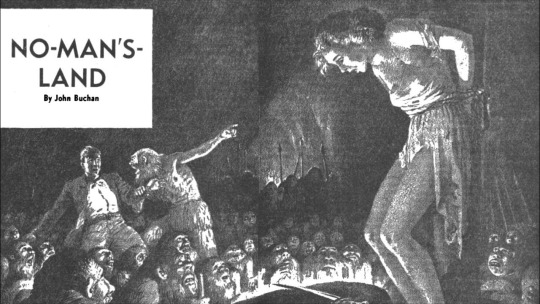
Another and scarier example of this trend would be "No Man's Land," a story by John Buchan, a Scotsman fascinated by paganism and horror, who often wrote stories of horrific discoveries and evil rites on the Scottish moors. He is often reduced to being described as a "Scottish Ghost Story" writer, a painfully reductivist description as in his career, Buchan wrote a lot of thrillers, detective, and adventure stories as well. In later life, he was appointed Governor General of Canada, meaning he may be the first head of state to be a horror writer.
It was Buchan who first identified the cave creatures with the Picts, something that another Weird Tales writer decades later, Robert E. Howard, would roll with in the 1920s.
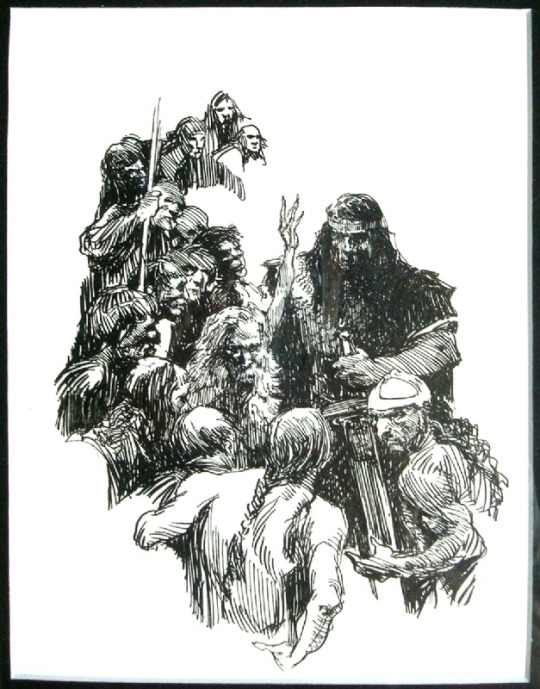
Howard is a very identifiable kind of modern person you often see on the internet: a guy who talks tough, but who was terrified to leave his small town. He created manly man, tough guy heroes like Conan the Barbarian, Kull, and El Borak, but he himself never left his mother's house. It's no wonder he got along well with his fellow Weird Tales writer and weird shut in, HP Lovecraft. With 1920s Weird Tales writers, despite your admiration for their incredible talent, you also can't help but laugh at them a little, a feeling you also apply to a lot of Victorians, who achieved incredible things, but who are often closet cases and cranks who died virgins ("Chinese" Gordon comes to mind, as does Immelmann).
With Howard, his obsession with the Picts and the stone age cave dwelling people of Europe started with an unpublished manuscript where at a dinner party, a man gets knocked out and regresses to his past life in the Bronze Age, where he remembers the earliest contact between modern humans and the original inhabitants of the British Isles, the evil darkskinned Picts. This is a mix of both the "little cave people" story and another cliche at the time, "the stone age past life regression novel," another turn of the century cliche.
Still with the Picts on his mind, Howard would later create Bran Mak Morn, a Pict chieftain, who predated Kull and Conan as his Celtic caveman muscle hero. Howard was of Irish descent and proudly anti-Colonial and anti-British, with his Roman Empire and Civilized Kingdoms as a stand in for the British and other Empires, which he viewed as rapacious and humbug, a view shared by his greatest inspiration, Talbot Mundy. His "Worms of the Earth" gets to the heart of why these little cave people scare us so much: they remind us that we live on land that is impossibly ancient and we don't fully understand at all.
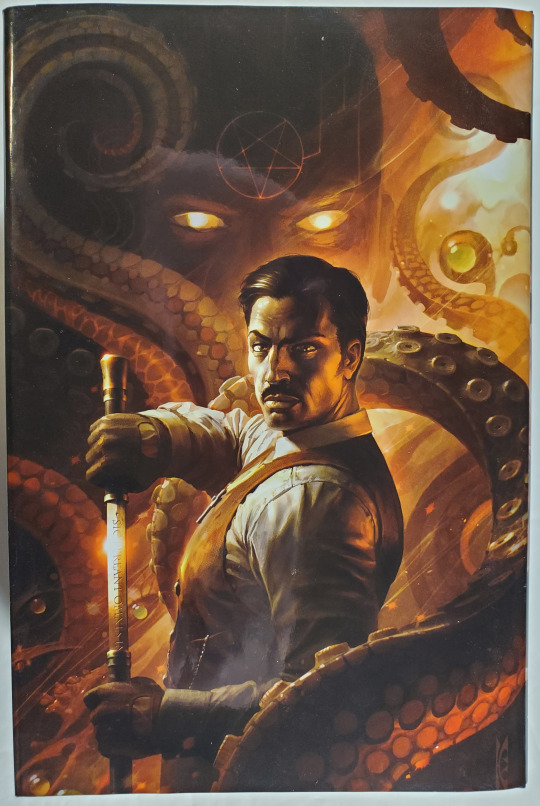
It was another Weird Tales Writer a decade later who wrote one of the last stories about the little hairy cave people of Europe, though, Manly Wade Wellman in 1942. Wellman was mainly known for creating the blond beefcake caveman hero Hok the Mighty set in stone age times, and for his supernatural ghost stories of Silver John the Balladeer set in modern, ghostly Appalachia (like many ex-Weird Tales writers, he made a turn to being a regional author in his later career, in the same way Hugh B. Cave became a Caribbean writer), but Wellman also had a regular character known as John Thunstone, a muscular and wealthy playboy known for his moustache who used his great wealth to investigate the supernatural and the occult. Thunstone had a silver sword made by St. Dunstan, patron of Silversmiths, well known for his confrontations with the Devil.
Most John Thunstone stories featured familiar stories, like a demon possessed seance and so on, but one in particular featured a unique enemy, the Shonokins.
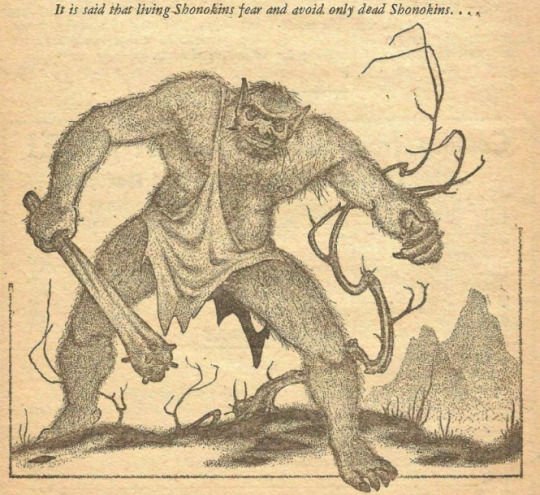
The Shonokins were the original rulers of North America, descendants of Neanderthal man displaced by American Indians. This fear that the land we live is ancient and unknowable and we just arrived on it and don't know any of its secrets is common to settler societies, who often hold the landscape with dread, as in Patricia Wrightson's fantasies of the Australian Outback. It was easy enough to transport the hairy cave people from the Scottish Moors to North America. I suspect that's what they are, a personification of a fear shared in the middle class, that in the back of their minds, that everything they have supposedly earned is merely an accident of history, built by rapacity and the crimes of history, and that someday a bill will come due.
A text page in the May 1942 issue of Weird Tales gives strange additional information on the Shonokins not found elsewhere:
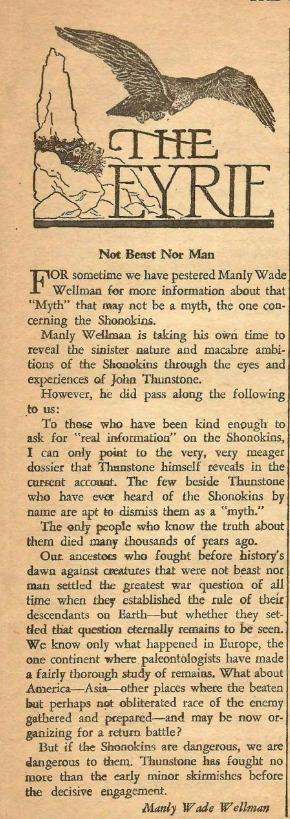
Since then, there have been too many examples of evil cave people who predate Europeans. Philip Jose Farmer's "The All White Elf" features the last survivor of a pre-European people who live in caves. A lot of other fiction of course has featured the Picts, but according to our modern scientific understanding, which describes them as much, much less exotically, as a blue tattooed people not too different and practically indistinguishable from the Celtic tribes that surrounded them, and which they eventually blended into.
458 notes
·
View notes